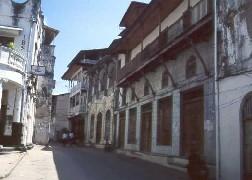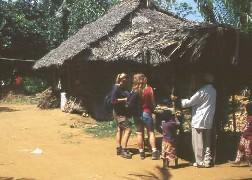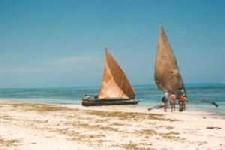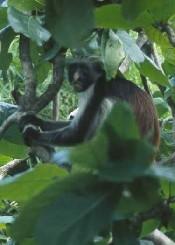Zanzibar
| Stone Town | Spice Tours | Beaches | Excursions |
|
I don't like resorts. Don't get me wrong, I like relaxing in the sun doing nothing except maybe reading a book, swimming in warm ocean water and even snorkeling. But I don't like resorts. Before I started my trip to Tanzania, the only thing I knew about Zanzibar was that it was in the title of a science fiction novel called Stand on Zanzibar which does not even take place in Zanzibar, and that Freddie Mercury of Queen was born there. After some preliminary research I knew it was a former Oman colony and terminus of the Arab slave trade, the world's largest producer of cloves and its beaches were largely untouched by commercial tourism. Sounded like the perfect place to end a safari. The first thing you notice about Zanzibar when you arrive, whether by air or water is that even though Zanzibar is part of Tanzania the authorities will stamp your passport again and check your yellow card (yellow fever innoculation). Zanzibar, although a poor underdeveloped island, appears richer than the rest of Tanzania and enjoys a degree of autonomy from the rest of Tanzania. Probably something similar to what Quebec might want. Zanzibar is often the collective name of Tanzania's offshore islands, with the largest called Unguja which most people think of when Zanzibar is mentioned. Two other large islands, which I never visited, are Pemba where the real centre of clove production is located and Mafia island which might become the location of Tanzania's first marine park and at the moment seems to be a haven for sport fishermen and scuba divers. Stone Town
The largest community on Unguja is called Zanzibar Town or Stone Town, although Stone Town generally refers to the older section of the town. If you have never being to an Arab community, Stone Town is a good example of one with its Arab architecture, marketplaces, and winding narrow streets lined with whitewashed houses many with overhanging wooden balconies. Its atmosphere is also more relaxed than the medinas of old Arab towns in the Middle East or North Africa which at times can be a bit intimating . Along the waterfront are located several Sultan palaces built by the Oman sultans and an Arab fort that was built by the Portuguese. Within Stone Town there are probably over a 100 mosques and two Christian churches, including the Anglican cathedral which stands on the site of the old slave market. Although there are maps of Stone Town available, its best just to wander about and notice the many courtyards, mosques, and bazaars. You will never really get lost since eventually you will end up at the waterfront or on the main street along Stone Town east side. As you wander in Stone Town you will see plenty of decaying buildings along with some restoration work being done on some of the more important buildings. Now that the area has been declared a World Heritage area maybe needed funds can be put toward ending the decay. 
Until recently, tourism was not encouraged in Tanzania and as a result accommodations usually consist of high end hotels for business or foreign aid agency travelers and small cheap hotels for locals. The accommodations situation is not as bad on Zanzibar which has always encouraged some tourism and thus has a wide range of accommodations. Although there are rooms outside the historic town, they are often characterless, stay in Stone Town. The more expensive hotels seem to cater toward package tourists, it appears mainly Italian. Many of the hotels are converted mansions with inner courtyards and are worth the extra money. On Zanzibar, all hotel bills have to be paid in foreign currency, preferably US dollars. The exit tax off the island, either by water or air also has to be paid by US dollars. Although the many forex bureaus will exchange most foreign paper currency, including Kenya shillings, they will only change US traveler cheques. One of the many reasons to travel is to experience the cuisine of the countries you visit. There is a reason why you don't find Tanzanian restaurants outside Tanzania. Most of the meals seem to consist of barbecued meat, vegetarians beware, and a bland, but filling, corn meal called ugali. Usually the best restaurants in Tanzania are Indian, most large towns will have at least one. You still get barbecued meat and ugali but in an Indian restaurant its generally served with a sauce and if your willing to spend a few more shillings you can get mashed plantains or even rice. On Zanzibar there is some sort of culinary tradition of Swahili cooking which is a mixture of African, Arab, and East Indian cuisine, its pretty good plus there is plenty of seafood. The cheapest, and probably the best place, to eat in Stone Town is called the Jamituri Gardens which is an open air market in front of the fort that starts with the sunset. Health experts might cringe at the sight of all those open air booths but the food is cooked in front of you and it seems popular with both locals and travelers. Most food items like barbecued kebabs of various types of meat or fish will cost about 400 shillings (1 US dollar = about 700 shillings), deep-fried plantains about 200 shillings and fresh boiled lobster can be had for only 1000 shillings, I had three. We encounter the Ugly American again as he closely supervised the preparation of his and his' wife food as she dutiful sat watching. Fresh squeezed fruit juices, sugar cane juice, spiced ice cream and yogurt are also available usually around 100 shillings. These foods especially are the foods that health officials warn you about so you have to judge for yourself. Generally I figure once you have been in a country for a couple of weeks your system is use to the local fauna of bacteria, of course that is just my opinion since I still only use bottle water. Both of my traveling companions came down with a case of the Tanzania Trots while we were on Zanzibar, I blamed the yogurt which I never had but they did but the fruit juice and ice cream were very good. Spice Tour
One of the most popular tours of the island are called spice tours. There are plenty of touts around town offering the trip. Your best bet is to book a trip with Mitu who first started the tours. Mitu suffers from malaria and is often not well enough to conduct the tours himself but he has trained many people. On the day we took the tour Mitu was the guide tour for part of the tour. Since it was a large group it was divided into two groups with the twentysomethings in one group and the 30 plus in another group. Myself and my wife were in the 30 plus group of 7 people which included two Canadian oversea development workers, another Canadian who quit his job to spend a year traveling around Africa, and two British women on a short vacation. These were the first Canadians we meet on our trip and once they found out we were also Canadians they started to ask us questions about current events in Canada. But soon the conversation turned to hockey. As one of the British women said, "Put a group of Canadians together and in less than 5 minutes they are talking about hockey." It might be a stereotype but its often true. A spice tour should cost about 8000 shillings which will include a lunch of spiced rice, fish and sauce with fresh fruit. The spice tours not only offer trips to various spice and fruit farms where you can sample the produce but also visits to some of the Arab ruins around the island including several Persian baths and they generally end with a refreshing dip at an undeveloped beach. Beaches
The main reason most people come to Zanzibar are the beaches. The island is surrounded by them with most people preferring the beaches on the east side of the island. The beaches on the west side are too close to Stone Town with its shipping, coastal pollution and even occasional reported muggings. The east side is underdeveloped, often without electricity and no swimming pools, casinos, nightly entertainment, bars or discos. That's my idea of paradise. We spend three days in the Stone Town area before heading to a beach. There are many to chose from but they are all very similar, except for Nungwi which is the furthest from Stone Town and does not have any seaweed but its a small beach. Many travelers were warning us not to go to Jambiani beach, "Everyone goes to Jambiani go to Nungwi, no one goes there." After having several people tell us that they were going to Nungwi beach because no one goes there we decided to go to Jambiani. Jambiani has a very long beach, over two kilometers, with many guesthouses. There would have to be a lot of people at Jambiani to make it feel crowded. The water is full of seaweed at low tide which the locals dry and sell to the Japanese market. There is not much to do at the beaches, but then that's the idea. The beaches are really small fishing villages and since this area of Zanzibar is made of coral the only farming is livestock rearing. You will encounter touts here who will arrange snorkeling or scuba trips via dhows, trips to view the red colobus monkeys in the Jozani Forest, or go swimming with the dolphins at Kizimkazi. All are worthwhile excursions. ExcursionsThe island is surrounded by coral reefs which on the eastern side of the island is only about 100 metres from the shore but the water near the shore is often full of seaweed, especially at low tide and there are many sea urchins and stone fish which can be painful and even deadly on unprotected feet. For only 2000 shillings you can get a trip to the coral reefs for about 4 hours on a traditional dhow sailing boat to enjoy some snorkeling. On one of my trips I went spear fishing for octopus with one of the locals. The water temperature is always in the high 20's Celsius and the water is crystal-clear. There is also several PADI certified centres on the island were you can not only scuba dive but take a course to get your PADI certification. 
The only protected area on Zanzibar is Jozani Forest, the rest of the island has been turned into various types of farms. Several species of animals can be seen in the forest including two species of antelope, and the Zanzibar duiker and sunni. Leopards once inhabited the island but are now extinct. The main animal people come to see is the red colobus monkey. Although usually a shy animal several groups have been habituated to humans and you can get very close. Although you are told not to feed the monkeys I did see some people feeding them. Trips to the Jozani Forest can be arranged in Stone Town or you can rent a bike from one of the guesthouses on the beach, one of the young men from the community will gladly act as a guide. Swimming with the dolphins at Kizimkazi is another popular excursions although it probably should be called harassing the dolphins or dolphins swimming by humans. The pick up of people at various guesthouse in various communities seemed to be an amazing example of third world efficiency. I never saw a single cell-phone or other mechanism of organization but the van that picked me up at my guesthouse also picked up people from other guesthouses in Jambiani and also picked people up in Paje and Bwejuu. We were dropped off in Kizimkazi where we were supplied with mask, fins and snorl and a boat took us out into the bay to look for dolphins. Being from Newfoundland and knowing the regulations that protect whales from harassment from whale watching tours some of the behaviour of the boatman on the swimming with dolphin excursions was distressful. Sometimes I think the dolphins were teasing the humans. The dolphins would surface, about 6 boats will speed toward them and as the boats got close the boatman will yell "In the water, in the water". Of course as soon as you were in the water the dolphins would speed past you. All you would see underwater was the grey shape of a dolphin as he torpedoed by you. The boatman would yell "Back in the boat, back in the boat" and as soon as everyone was back into the boat we would chase after the dolphin again. While this was happening someone on my boat yelled "Look its the obnoxious American". Sure enough it was the Ulgy American, I see he impressed other people. After about three hours chasing dolphins, a few people were feeling sea sick, we did some snorkeling for about an hour at a reef. Lunch consisted of fish and rice served with a spice sauce and fresh fruit. There was plenty of kids around selling fruit; mangos for a dime, large melons 15 cents, and bananas cost about 50 cents for a kilo and I was probably overcharged. I've mentioned muggings but don't worry too much, Tanzania is a law-abiding country.Considering how poor the country is, I was surprised how few beggars I saw, plenty of touts but few beggars. I've seen more beggars in any large city in North America or Western Europe than in Tanzania. Our flight was leaving from Nairobi and after almost a week on Zanzibar we had to find a way back to Nairobi. Our options was a two hour boat road across the Zanzibar Channel to Dar-es-Saalam for US$20 or a 45-minute hydrofoil ride for US$30, then a 13 hour bus ride to Nairobi for US$20. Or a one hour flight on Air Tanzania for US$120. We flew. |
|
| Visit Northern Tanzania | Visit Southern Tanzania | Return to Travel Page | Return to Main Page |